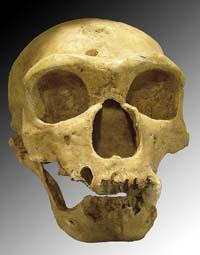Neanderthals and modern human beings met in Europe, in doubt

New dating has shown that Neanderthal fossils are older than expected.
Neanderthals disappeared earlier than expected, according to an article published in PNAS magazine. Therefore, the image that Neanderthals and modern humans were in Europe is false.
Archaeologists from the Irish universities of Cork and the British universities of Oxford and the Russian Prehistory Laboratory have jointly conducted the research that has been exhibited at the PNAS. In this research, using a dating method developed at the University of Oxford, they calculate the age of the fossil of a Neanderthal Caucasus child
The Oxford method is based on the isotope of carbon 14, as the classic method, but to avoid contamination of a younger material, the sample is ultraviolet. In this way the result is much financed. And so it has been seen that the fossil is 39,700 years old and not 30,000, as suggested by traditional dating methods.
For this reason, a statistical analysis of pre-Neanderthal fossil dating has been carried out, from the fossils of Russia, northwest of Europe, to Spain, southwest. None of these fossils are younger than 40,000 years ago.
However, this does not doubt that there was a crossing between Neanderthals and Homo sapiens. Precisely, according to a work published last year, modern man has Neanderthal genes in his DNA, which shows that they crossed. This crossing, however, probably took place in the Middle East, not in Europe.
UPV archaeologist Alvaro Arrizabalaga agrees with this vision: "While prudent, I am convinced that future research reinforces what Oxford researchers and colleagues present."
Arrizabalaga knows the Oxford dating method very well. In fact, it has been used in an important site located in Arrasate, in the Labeko Cave, where the results obtained are, according to Arrizabalaga, "specimens throughout the Iberian peninsula". These results have become, to a large extent, the result of the characteristics of the cave, which is a "time capsule", since for 32,000 years it was filled with sediments and since then no one or animal has been introduced. Thus, it has a net record of between 4,000 and 5,000 years. Well, the results obtained by the Arrizabalaga team coincide with the vision they have presented now.
However, other researchers consider that there are indications of younger Neanderthals. For example, the director of the Gibraltar Museum, Clive Finlayson, argues that the fossils of some Neanderthals found in Gibraltar are only 24,000 years old.
After all, Oxford team leader Thomas Higham told Nature that "Eurasia is a very big place and there seems to be no reason to think that no Neanderthal population survived somewhere." Therefore, the debate is not decided at all.





